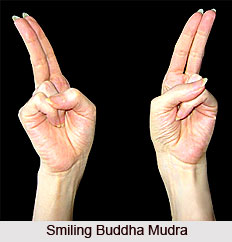 This is a gesture and exercise of happiness as it opens the flow of energy to the heart. Be it any other emotions like fights, worry, depression, impatience, anger, fear and others, this Mudra can be done anywhere.
This is a gesture and exercise of happiness as it opens the flow of energy to the heart. Be it any other emotions like fights, worry, depression, impatience, anger, fear and others, this Mudra can be done anywhere.
•Sit comfortably either with crossed legs or on a straight backed chair.
•Bend ring and little fingers, pressing them down with the thumbs and keep the index and middle fingers straight but you should be comfortable, and should not force the fingers straight and push the palms forward.
•Then push elbows in towards the body as far as it feels comfortable for you and keep a 30-degree angle between the upper arms and the forearms. Keep the forearms parallel to each other.
•Concentrate on your Third Eye and mentally chant Sa Ta Na Ma (Sa - Infinity, Ta - Life, Existence, Na - Death, Ma - Rebirth, Light). It can be done without the chant but try to at least concentrate on your Third Eye. The focus is essential.
•Keep elbows in towards your body and your chest out but also have a straight back.
•Then continue for about 10 minutes, inhale deeply, exhale, open and close the fists several times, and relax.




















